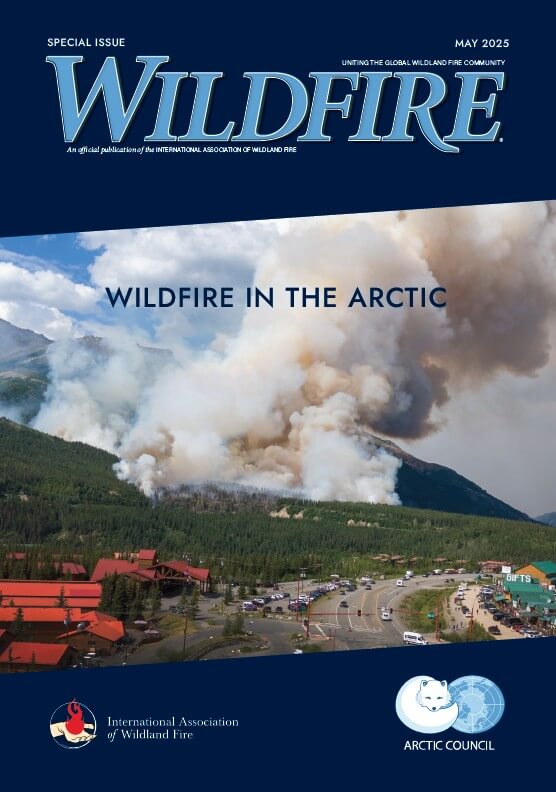THE ARCTIC MONITORING AND ASSESSMENT PROGRAMME: MEASURING THE IMPACT OF SMOKE, SOOT AND EMISSIONS
BY SIMON WILSON AND ROLF RØDVEN
Wildfires are a natural part of the boreal system and of some Arctic ecosystems. However, in recent years, increases have been observed in the frequency and intensity, as well as the timing and characteristics of Arctic wildfires. These observations are consistent with the higher temperatures that PROGRAMMEare a result of the rapid climate change that is affecting the Arctic in so many ways.
With continuing climate change, the risk of wildfires in the Arctic is projected to further increase as drier conditions, more fuel, and more lightning strikes increase the likelihood of major fires. The expansion of human activities into wilderness areas adds increased risks of accidental ignition of wildfires to the natural causes such as lightning strikes. Humans, either intentionally or unintentionally, are responsible for about half of Canadian wildfires and more than 90 per cent of wildfires in Europe. Due to their remoteness and limited access, wildfires in some parts of the Arctic are almost impossible to combat using traditional firefighting techniques.


As climate change accelerates, Arctic wildfires are becoming more intense, more frequent — and harder to fight.
The Arctic Monitoring and Assessment Programme (AMAP) – the working group of the Arctic Council that is responsible for monitoring and assessing the state of the Arctic with respect to pollution and climate issues – undertakes work to better understand causes and impacts of wildfires and other types of open burning impacting the Arctic and its people. Of particular interest to AMAP are the emissions of carbon dioxide, soot and other potentially harmful substances that arise from wildfires impacting the Arctic. For example, in June 2019, Arctic wildfires emitted 50 megatons of carbon dioxide, equivalent to Sweden’s total annual emissions of carbon dioxide (CO2).
Wildfire emissions can further enhance climate change through climate feedback mechanisms and impact the health of populations through exposure to smoke as well as the direct risk from the fires. AMAP’s work has a particular focus on providing insight into both current and future emissions associated with changing Arctic and boreal fire regimes. Timing of fire emissions relative to the presence of snow and ice is an important factor in relation to Arctic climate impact. Wildfires emit black carbon and organic carbon particulates. Black carbon, a so-called short-lived climate forcer (SLCF), warms the atmosphere through its radiation absorbing properties and, like organic carbon, scatters light in the atmosphere. When soot (black carbon) is deposited on snow and ice, it reduces reflectivity – or albedo – leading to enhanced surface warming. Altered seasonality and locations of fires could lead to either more soot deposition (earlier fire regimes) or less soot deposition (fires later in the season) on Arctic snow and sea ice. It has been estimated that 12 per cent to 15 per cent of the total deposition of black carbon in the Arctic originates from boreal forest fires in Siberia, Canada, and Alaska.
Smoke and soot from wildfires can spread far from the burning site and create a serious health hazard when they reach populated areas. A study of Siberian wildfires in 2012 showed that about one quarter of the huge emissions of black carbon from these fires were transported into the Arctic. In May 2023, the major wildfires in Canada resulted in transport of smoke to the Arctic that was modelled by the Norwegian Institute of Air Research (called NILU) as a contribution to AMAP and the ABC-iCAP project (Figure 1 and 2).
Emerging concerns for Arctic wildfires are peatland and tundra fires that tend to smoulder, producing greater amounts of particulate matter emissions compared to open fires. Some peat fires can persist for years, burning underground and re-emerging to ignite surface vegetation the following fire season. Climate change is shifting the fire regime in ways that could turn boreal peatlands into a net source of carbon dioxide instead of a carbon sink. Additionally, climate warming is leading to permafrost thaw, which, exacerbated by burning peatlands, is releasing methane – resulting in another feedback that warms the climate faster and further.
While Arctic wildfires, in particular, are difficult to control, proper management can reduce emissions of CO2 black carbon and methane and their associated impacts on climate, prevent loss of natural resources and property, and reduce risks to human health. How wildfires are best managed depends very much on local ecological conditions, weather patterns, site access and proximity of people and infrastructure, as well as the national and sub-national regulatory and fire management systems.
Mitigating risks associated with Arctic wildfires involves development of monitoring and surveillance systems that help to detect fires when they are still manageable. Monitoring systems that can detect small fires, peat fires, open burning in croplands, or early and late season fires from satellites are largely lacking. Establishing a more reliable monitoring and surveillance system requires improved satellite and ground-based observation networks for the boreal and the Arctic, co-produced with Indigenous and local populations who live with the fire risk.
AMAP’s work will continue to contribute to the development of tools that can be used to estimate emissions from wildfires and assess both their climate and air quality impacts, complementing other work by Arctic Council groups and other initiatives that addresses the human dimension of Arctic wildfires and their consequences and work to reduce the risks to Arctic human populations.


